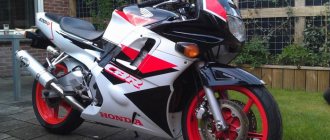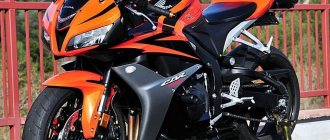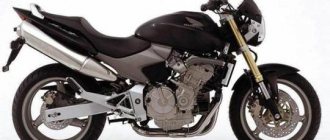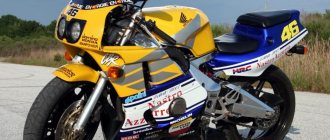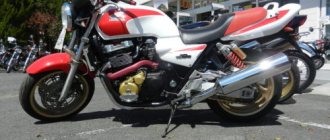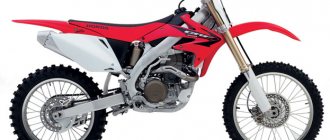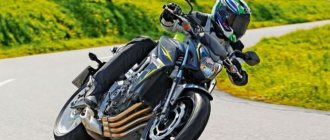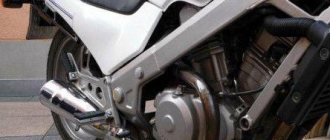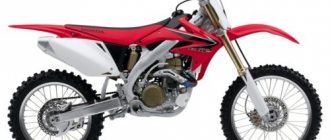The Hurricane model, officially named Honda CBR600F, was already mentioned on the project as a prototype for the 600 cc RR. But five (5!!!) generations, the tough fight for the championship with Fazer (FZ6) from Yamaha and the decision to restore production after a 5-year inactivity are worthy every respect.
First appearing in 1987, it was produced for 18 years.
In 2006, the fifth generation was removed from the assembly line. Then 2011 comes and the model goes into production again, although only the name remains from the Hurricane. Everything changes, from frame material to driving characteristics - a motorcycle from a sports motorcycle becomes a road bike . And in 2013, the Honda CB600F Hornet model finally goes down in history. Place on the assembly line is transferred to the more powerful, more modern Honda CB650F.
Honda CBR600F design
The first three generations (~ 12 years) the model was assembled on a tubular steel frame.
The photo shows a 1994 Honda CBR600 F2 (2nd generation) on a steel frame with a square headlight.
A double pipe was used to strengthen the structure. In 1999 the material changes to aluminum . The design is the same - tubular. Only the new model, launched after the break, began to receive a cast frame.
- Rear suspension was produced according to the standard principle - mono shock absorber + swingarm. Over 18 years, the working progress has increased from 110 to 120 mm.
The latest generation rear suspension is based on an aluminum Dual Box swingarm paired with a Monoshock shock absorber.
- The front has changed from generation to generation. During evolution, the diameter of the fork feathers increased by 5 mm, before 43 mm on the fourth generation. The first versions were equipped with a standard version. Starting from the third generation, since 1995, Honda’s own design appeared on the motorcycle - a fork HMAS. The changeling appeared only in the latest versions based on the road-going Hornet. During production, the ability to adjust the suspension on your own also underwent changes from zero on the first generations to full on the fourth and fifth.
The front fork absorbs road imperfections well and provides the right level of kickback for safe cornering.
It’s interesting that when production was resumed, the suspension was cut in all respects. The diameter of the feathers became smaller, adjustments were reduced to a minimum, and the working stroke of the shock absorbers also became smaller.
As part of the new generations, the motorcycle received various goodies and additions, the most important of which was the replacement of the carburetor with an injector in the latest, fifth version
Exterior
Despite its sporting purpose, the motorcycle is quite comfortable to drive, and a full set of optics, mirrors, space for a second number plate and even a small offset sufficient for installing a trunk allows it to be used as a sports tourer.
Left view.
Right view.
An additional advantage is the presence of a PTS, and therefore the ability to register, which will allow it to be used on additional roads.
Front end
- It is quite easy to distinguish a Hurricane from a Hornet - by the headlight. The most popular, fifth generation ( 2001–2006) has a claim to "fox eyes" The tourist has one irregularly shaped headlight. The first versions of the bike also had one headlight, but in a square design.
Honda CBR600F Hurricane with two headlights.
Honda CBR600F Hornet with one headlight.
- Fox eyes, rather a prop, are clearly visible behind their glasses round reflector of a regular lamp. They turn on as standard, for the near one one eye, for the far one - both. The headlights are inserted into a large body kit, the top of which is crowned by the windshield. But it is small, designed for a sporty fit. When sitting according to the classics, it is not enough.
A distinctive feature of all Honda CBR600F models is a full aerodynamic body kit.
- The mirrors are large and square in shape . They are the most protruding part, so be careful when traveling in traffic. Although they are located high, the overall low stance of the bike lowers them to the level of the “ears” of passenger cars. The developers deviated from the standards in the design. The mounts are not on the body kit, as is customary with Honda, but on the steering wheel. This expands the customization options, allowing the rider to turn them so that they can see the road situation, and not their limbs.
- The turn signals are traditional - yellow “candles” on stands attached to the side edges of the body kit . They are located quite low, at the level of the lower part of the body kit. The latter descends almost to the wing, the technological opening for air intake is minimal. The wing itself also changed during evolution until it took on a non-standard, stepped (when viewed from the front) appearance. The main part is pressed tightly against the tire, the steps on the sides are a kind of covers for the fork legs.
Dashboard
The modern design of the “tidy” allows you to literally control the speed and number of revolutions at a glance.
The main data is presented here in two blocks. Pointer tachometer (marked up to 17 , red at 14.5 , recommended at 12 ) x1000 . It has a built-in temperature indicator. The second block is a large LCD screen.
After a standard startup check it displays:
- clock and indicators for oil availability and engine temperature (the latter with a pair of icons);
- fuel indicator and speed (standard – bar and numbers);
- trip 1, trip 2 - the last few mileage readings (adjustable using the buttons to the left of the screen).
While driving, the display shows information about current and average fuel consumption.
The same block includes other indicators, made in one line. Among them:
- turn indicators;
- neutral;
- turning on the high beam;
- self-diagnosis lamp;
- An interesting feature is the presence of a blinker (a blinker indicating that the speed limit for Japan has been exceeded) - the model was not officially sold in Japan.
The ignition key is slightly lower, the well is covered with a curtain.
The ignition key can be removed from the lock in the OFF or LOCK position.
According to user reviews, the devices are more than sufficient; the main data (speed/rpm) can be caught at a glance . When errors occur, the indicators light up very brightly, and the self-diagnosis light (labeled F1) indicates by the number of blinks where to look for the problem.
Back view
The optics are presented in a complete set. The same turn signal bulbs as the front and brake lights in the same housing with dimensions.
Rear optics.
Exhaust system muffler.
- The bike's saddle has also gone through some evolutionary path from common for two passengers to separate perches. Both options found their use in 2001.
- Models of recent years have one saddle, which is clearly divided into two parts. Due to their specific tilt, the second number can look over the driver’s head.
Gas tank
There is a keyhole hidden under the flap on the neck of the gas tank; the key is the same as for the ignition switch.
The gas tank is large, holds 18 liters .
(latest editions). Located in a standard place, but the design is not very convenient. Due to the pronounced angle near the driver, sitting in a sporty style can be a problem for tall motorcyclists.
000_moto_0211_056
Honda CBR250R: Roadster, 2011, 249.4 cc, 26.2 hp, 165 kg.
Honda CBR250R: Roadster, 2011, 249.4 cc, 26.2 hp, 165 kg.
At the same time, the “chekushka” supplemented the “bottom” range of Honda roadsters - the company’s second Main Breadbasket in the old-world markets, and - most importantly - headed the extensive family of “utilities” in the Asian markets.
Just don’t mock the letters R in the name, deciphering them in a new way! Indeed, this combination of power and weight is more consistent with the good old Jawa 350 or a large-wheeled utilitarian scooter; for example, Honda's SH300. But the SH300 in Europe is offered for 4,500 euros, and the new CBR250R will cost half a thousand less than the “luxury string bag” - and this is already the territory of more modest devices. Let's say the Aprilia Sportcity 300, which weighs almost the same but has 22.4 horsepower.
And the approach to design here is similar to Sportcity: behind the cladding a la sport is a simple, but without primitive, “filling”. Moreover, unlike some competitors, it is entirely and completely modern in design. The frame is open tubular, but its shape hints that the development was carried out in an era when strength and rigidity can be calculated, and not estimated by eye. The suspensions are the simplest, but the Japanese considered it inappropriate to abandon the “progressive” rear (previously they easily did this for liter roadsters, but here they decided that comfort was more important). And the brakes may not be the most “advanced,” but they do have ABS, albeit optional.
The engine was developed in a similar vein. With a wet (and not dry, like enduro engines, and not semi-dry, like the CRF or the same SH300) crankcase, four-valve and two-shaft. But - with roller pushers to reduce losses, and the twisting of the channels, although purely “civilian”, still implies a certain potential for forcing. This is also indicated by the throttle diameter: 38 mm (for the 27-horsepower and 280 cc SH300 - 34). And the low end is well supported by a long, tapered intake pipe, most of which extends deep into the airbox. One more point: the main crankshaft supports are on liners, and the toe support, located in the cover, as well as the balancer shaft and pump supports, are on ball bearings. I see this scheme as optimal in terms of “survivability-repairability” ratio.
The latter is also useful in affluent Europe, the USA and Japan, where a motorcycle is intended to become both an alternative to a scooter - which means it can often be started “cold” - and a simulator for beginners, regularly changing their not very competent and thrifty owners. And this is especially true in the main Asian markets, where the CBR250R will be “premium” by local standards, but still a workhorse, mercilessly driven by its not the most technically competent owners. And all these above-mentioned comrades will appreciate... no, not the style, but the ego-flattering external resemblance to “full-size” Honda motorcycles. And the design is not extravagant (no need to scare the average person!), but modern in every detail, from the wheels to the dashboard. Not a single hello from the time when the most decrepit of the current second-hand stores were the new items of the season.
And that there will be one version, without any “nudity” or “intersection” there, is both logical (it looks richer and hides the cheap “filling”) and technologically. And the chosen production location (like that of the Main Competitor - Thailand plus assembly for local markets in India and, possibly, Brazil) is both budgetary and logistical.
Specifications
As the developers admit, the increase in power in new generations of bikes was achieved by boosting the engine.
Throughout the entire production period of the motorcycle, the engine underwent cosmetic modifications.
If the diameter of the piston increased, then in order not to go beyond the boundaries of the volume it was necessary to reduce the working stroke , which amounted to forcing. Thus, over 18 years of operation, the external parameters of the engine have not changed. It was a 4-cylinder, 4-stroke unit with in-line pistons, which produced:
- working volume - 598 cm3;
- power - 87–110 hp (depending on the year of manufacture);
- number of valves - 16 (4 per cylinder);
- cooling - liquid;
- fuel supply - carburetor or PGM-FI (Programmable injection system in the photo);
- ignition - transistor (CDI);
- start - electric starter;
- fuel tank - 18 l.
The choice between an injector or a carburetor began to be provided to the buyer only in 2001. The version with an updated fuel supply bore the symbol “i” in the name. CBR600F F4i . The bikes of the second wave had an injector in stock.
Transmission and clutch
A cover on the engine behind which a multi-disc clutch operating in an oil bath is hidden.
Despite the large number of changes in the engine part, the chassis has not received any changes. From the first models, a 6-speed gearbox . It was rebuilt several times, changing gear ratios, but the main characteristics remained unchanged. There is also a strange feature of the clutch basket - a metallic noise that occurs when operating in neutral.
Shifting into gear or pressing the clutch handle - the sound becomes normal. The mechanics say that it can be fixed, but this is a feature of this bike and “there is no need to worry about it.”
- Multi-disc clutch , oil bath, power transmission - hydraulics.
- The main drive is a chain.
The chain drive is one of the most loaded components on any sportbike. When purchasing a used motorcycle, you should pay attention to the condition of the chain and sprocket.
Brakes
The solution to the 4th generation models looks interesting. On them, the front disc received 4-piston support, and this is without the optional features that were available to owners of the “new wave”.
The drive is hydraulic.
Reliable operation of the front brakes is ensured by a pair of floating discs.
Front brakes:
- number of disks - 2;
- diameter - 276 (until 1999) 296 mm;
- support - 2 (4 since 2001) piston.
Rear brakes:
- number of disks - 1;
- diameter - 220 mm;
- support - 1-piston.
ABS was an option , but it was offered only to buyers of recent models.
Driving performance
In terms of its driving characteristics, the Honda CBR600F is quite suitable for long trips, for “burning in”, and for driving around the city.
The maximum speed of the classic Hurricane was 210 km/h . But since 1991, when the CBR600F model received two trim levels, purely sporty and for every day, the speed of the first increased to 250 km/h .
Fuel consumption
Fuel consumption depended on the style of movement, the condition of the bike and the road surface, but during cruising riding it did not exceed 6 liters .
Acceleration to hundreds
Acceleration from standstill to 100 km/h also depended on the condition of the device, but was no less than 3 seconds .
Appearance
Yes, the history of this series of models is long, and it shows. Some angularity of features has been preserved. However, the Honda CBR 500 R is a motorcycle from the tenth century, which means that the lines here are much smoother than those of its distant predecessors. The gas tank is raised high, but not so sharply. The front includes an almost futuristic style headlight. At least, the lighting device has nothing in common with the round counterparts that were popular in the last century.
Bike is distinguished by a large number of elements in alloy wheels. So from a distance, when the wheels are not spinning fast, but not too slowly, it may even seem that the rims are spoked. The mirrors are large, but do not go beyond the sporty style. Their shape is a rectangular trapezoid.
Dimensions and weight
The color scheme of the bike changed with each new generation.
Each new generation of motorcycle production had different external characteristics and its own design features, but the weight of the bike had a positive tendency to decrease.
Over 18 years, dry weight decreased by 18 kg . ( 186 kg in 1999, 168 kg in 2006).
Curb - 9 kg ( 205 kg, 196 kg ).
The overall dimensions also depended on the edition of the bike; only the following remained unchanged:
- width - 682 mm , mirrors up to 690 mm ;
- the length increased from 2020 mm to 2050 mm (interestingly, the 4th generation with an injector is 10 mm shorter than the version with a carburetor - 2040);
- height - from 1115 mm to 1135 mm (again the injector is different - 1130 mm);
- wheelbase - from 1410 mm to 1390 mm (injector - 1386);
- ground clearance - from 140 mm to 135 mm.
The lowest point is the plastic aerodynamic body kit.
The seat height for all versions except the very first and latest editions was 810 mm.
Modifications
Starting in 1991, the model began to gradually transition into the category of tourists, and the developers had to think about a sports version.
All changes in the sports version concerned reducing the weight of the motorcycle.
In 2001, simultaneously with the launch of injection versions, the CBR600F F4 Sport . The amount of plastic on the model was reduced, and the center stand was also removed. This allowed the overall weight to be reduced by several kg.
But it should also be noted that American traffic rules require you to indicate speed in miles. But reconfiguring the control unit for km is quite simple from authorized Honda representatives. Temperature readings are also easy to switch, and the gauges work equally well without any additional adjustments.
Finally!
Finally, Honda is taking the issue seriously. We believed that they were capable of making such a motorcycle, and wondered why this had not happened for years. Well, it happened - and it’s wonderful. It's no exaggeration to say that this is the best thing Honda has done in years with the CBR line. There is only one question left - is their new product good enough?
Without putting it against the Ducati Panigale V4S, Aprilia RSV4 1100 Factory, Yamaha R1M, Kawasaki ZX-10RR on the track, it’s impossible to say. But what I am 100% sure of is that the new CBR1000RR-R is a significant step forward in its line. Several important changes make the new model impressive on the track, which is exactly what the CBR was looking for.
Flaws
- Low windshield . But the problem is solved by installing a tuned, higher one.
- Rear signal installation failed . Being in the rear stem, it is set back and down by default. It may not be visible to the driver behind a driving Kamaz. When installing a case, most users duplicate the stop on its reflectors.
- Lack of handles for the second number . For city driving it is not critical, but when installing side panniers, securing them is a problem.
- Headlight . The shape under the fox eyes did not bring much benefit. Users recommend installing xenon.
Owners of the first assemblies of the fourth generation say that the timing chain tensioner rattles at low speeds. It can be cured by installing the latest version.
and dignity
- Suspension. The soft system itself with a full range of settings allows you to choose the optimal performance for a wide variety of routes.
Shock absorption adjusters allow the rider to change the stiffness of the suspension at his discretion.
- Saddle . Double saddle like a road bike with the softness of a sofa. Paired with the suspension it compensates for any road problems.
- Landing . When cruising on the highway or leisurely around the city, you can sit like a classic - no problems, if you want to “fry” at 180, you will have to lie down on the tank.
- Mirrors . The mount, which is non-standard for the concern, allows you to configure it in such a way that even a biker with broad shoulders will not block the road behind.
- Engine . Good traction at all speeds, not “evil” character.
- Ease of control . Although the bike cannot be called light, it is well suited for girl bikers who want a Japanese, not a Chinese, “trotter”.
- Frame rigidity . Fourth generation bikes (2001–2006) are often chosen by those who like to rock out. A powerful motor and a strong frame allow you to “take on anything.” On the one hand, this is a plus, but the used buyer needs to be careful. The resource of parts is huge, but not infinite.
Maneuverability, controllability, dynamics - these are the epithets that characterize the “winglet” of both the first and second waves.
The slider is a very useful thing that saves fragile plastic from unplanned sliding on the asphalt.
Comfort
The board here is informative. This is especially important for a sportbike, because at high speed the driver has little time to look at the indicators. Unevenness is overcome well, but we are talking about the unevenness of a country road, and not about potholes or worse. The landing is comfortable.
It stands up well in turns and is easy to lean. It is also easy to transition from right to left tilt. This is not to say that the acceleration is sharp. But it is impressive, as are the dynamics in general, and such a car is not suitable for a beginner. Even those who have extensive experience riding road motorcycles may not be able to handle this technique.
